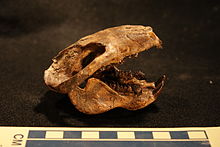| Meniscoessus Temporal range:
| |
|---|---|

| |
| Meniscoessus skull in the Rocky Mountain Dinosaur Resource Center, Woodland Park, Colorado | |
| Scientific classification | |
| Domain: | Eukaryota |
| Kingdom: | Animalia |
| Phylum: | Chordata |
| Class: | Mammalia |
| Order: | †Multituberculata |
| Family: | †Cimolomyidae |
| Genus: | †Meniscoessus Cope, 1882 |
| Species | |
| |
Meniscoessus is a genus of extinct multituberculates from the Upper Cretaceous Period that lived in North America.
It is a member of the order Multituberculata, belonging to the suborder Cimolodonta and family Cimolomyidae. The multituberculates were primitive, rodent-like mammals occupying the modern rodent ecological niche. They were significant for having diverged early in mammalian evolution, co-existing with dinosaurs for ~100 million years, surviving through the Cretaceous–Paleogene extinction event and lasting until the end of the Paleogene, likely having been replaced by true rodents.[1][2][3][4]
Meniscoessus lived during the Santonian, Campanian and Maastrichtian ages of the Upper Cretaceous. This was a period of significant diversification of multiturbiculates, and evidence that contradicts the popular misconception that mammals were unable to thrive due to being outcompeted by the dinosaurs.[5][6][7] They are useful as index fossils for the Judithian, Edmontonian, and Lancian faunal stages.[8] Like most early mammals, Meniscoessus fossils mainly consist of teeth. Zofia Kielan-Jaworowska and Jørn Hurum considered them to be the "best known" members of the Cimolomyidae.[9]